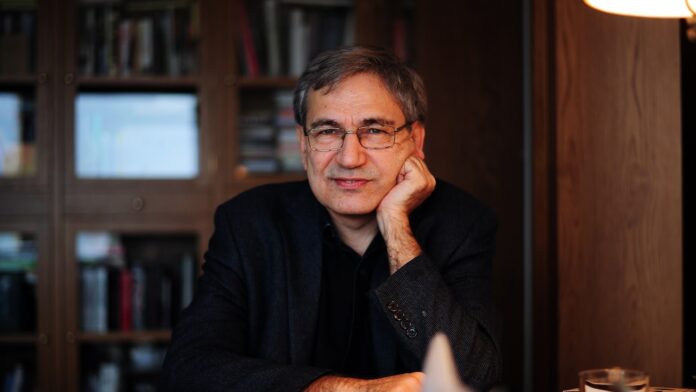Orhan Pamuk, the first Turkish Nobel laureate has given the postmodern literary world remarkable works. Born in 1952, Pamuk is a screenwriter, novelist, and academic. His areas of knowledge, apart from literature, are spread in many directions including Architecture Journalism, and most importantly Arts, towards which he was inclined much of his youth.
Orhan Pamuk often claims his work departs from politics and is more poetic. Pamuk has introduced a whole new aspect of postmodernism through his works. His literary techniques are often a contrast between the east and the west, even though Pamuk claims to keep his distance from political work, his work is often a reflection of western domination.
Pamuk is often quite sceptical of the tactics of the Turkish government, of the role it has played in the modernization of the country, and of how its policies are driving the masses away from its culture.
One of Pamuk’s early works is Cevdet Bey and His Sons. This work is a family saga set over three generations. This work depicts more of a realist image rather than the postmodern view like many other works of his. The three generations that are portrayed in this novel show three different perspectives on ageing. Pamuk has emphasized the importance of each character without glorifying them. He knows the subtle art of precision. Pamuk knows what information to reveal in words and what to leave for the reader to imagine. He won the Milliyet Press Novel Contest Award in 1979 for this work, but he could not publish it.
One of the most controversial works of Turkish literature includes The Black Book or Kara Kitap. Identity, time, and reality are important themes in the novel. It is considered to be a postmodern novel. This work has elements of Islamic mysticism and Sufi references. Critics often compare The black book with Joyce’s Ulysses because of its minute details and highlighting of the city of Istanbul. Enis Batur has said, “Orhan Pamuk penetrates the subconsciousness of the city.”
From being a part of daily controversy to being the fastest-selling author in Turkish history, Pamuk’s variety of works, through the years have been tremendously diverse. Snow, published in 2004, explores various aspects of society, from socio-political issues to themes such as marginalization, the east and the west. Like many of his other works, this one depicts the issues between the Arab world and the west, the relationship between Turkey and the West and Europe, and the influence of the modern world on the Ottoman Empire. The work Snow And his sixth novel, My Name is Red, brought him international fame, and led him to win the Nobel Prize
The book My Name is Red is in sharp contrast to the novel Snow. It suggests how the elite modernization of the Ottoman Empire and the Turkish republic are bound to fail because of deep-seated religious and cultural values in the Turkish people. It is highly negative of the East and Individuality. The novel shows why individuality is considered to be a negative aspect in the east.
Orhan Pamuk has shifted from realism to postmodern intertextuality through the years. This can be seen in his works from the 1970s, like The White Castle. The Red-Haired woman is based on the Greek classic by Sophocles, Oedipus Rex, and the Persian classics Rostam and Sohrab by Firdausi. Although Pamuk’s recent writings are Postmodern depicting intertextuality, he has covered genres and themes often left untouched by other writers, If we critically analyze his works, there is no one side or theme that he has been attached to. Many times his novels are a self-rebuttal, which can be seen in My Name is Red and Snow. He has created his realm of themes and genres, which have always existed but were not well explored. His works are frequently woven into politics, despite being far from it.
“One of my earliest memories is of homesickness, of wishing that I was somewhere else. But over time, I’ve come to view the idea of home as being overrated. There’s a lot of sentimentality about ‘homelands’ that I don’t care for. “And wandering around is really what I like to do most.”
These are the words of Edward Said from his memoir Out of Place published in 1999. Here he talks about his homeland, Palestine. Edward Said was a long-standing and historical figure of cultural criticism. We often find a certain contradiction in the writings of these two writers. When we view Edward Said’s theory of orientalism in the light of Pamuk’s work, a whole new aspect of criticism opens up. Pamuk has a distinct approach to Said’s work. Orhan Pamuk’s memoir Istanbul published in 2005, is a personal account of his homeland, Istanbul. This book explores the disappearing glimpses of the Ottoman empire. Identity and homeland and the pain of losing one’s history can be seen in both Pamuk and Said’s work. They follow an elegiac tone and recall the vanishing past—the memoirs of their childhood. Pamuk insists that Turkey was never a colony and hence Said never mentions it in his Orientalism. Pamuk wants to retrieve the Ottoman Empire through Istanbul, he takes into account the works of several European travelers for this purpose whereas Said considers the works of European travelers to be culturally draining.
Both authors experience a sense of loss that is both personal and political as well as cultural. The loss of his homeland has left an irreparable imprint on Said’s life. Pamuk laments the disappearance of Ottoman culture, which the Turkish government wiped out. Both of the writers are in the paradoxical situation of embracing the very authors who disparage their native culture, race, and ethnicity.
Orhan Pamuk is concerned with culture, ethnicity, and the diminishing values of the city of Istanbul and the Ottoman empire. His works do not commit to a precise subject or realm of an idea, but rather he writes freely, creating a myriad of images. This is perhaps an exceptional yet intimidating quality of his.




